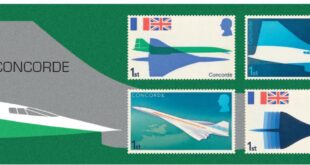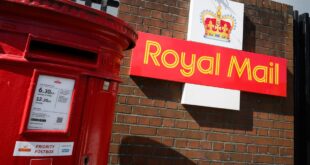ROYAL Mail is increasing the price of stamps again in just a few days.
The price of first-class stamps will rise by 30p to £1.65, the second rise in a year, the delivery giant has confirmed.
1
Royal Mail said the price increase will come into force from October 7.
It comes after first class stamp prices increased by 10p to £1.35 in April and by 10p to 85p for second class.
The company has frozen the cost of second class stamps at 85p until 2029 in a bid to keep the sending of letters affordable.
Royal Mail says it has tried to keep price increases as low as possible in the face of declining letter volumes, and inflationary pressures.
When announcing the price rise earlier this month, it also cited the costs associated with maintaining the so-called Universal Service Obligation (USO) under which deliveries have to be made six days a week.
Postal regulator Ofcom declared in early September that Royal Mail could be allowed to axe Saturday deliveries for second class letters as part of an overhaul of the service.
Ofcom, which has been consulting on the future of the universal postal service since January, said it should keep first class deliveries to six days a week.
Under the plans being considered, second class deliveries would not be made on Saturdays and would only be on alternate weekdays, but delivery times would remain unchanged at up to three working days.
Ofcom said no formal decision had been made and it continues to review the changes, with aims to publish a consultation in early 2025 and make a decision in the summer of next year.
Royal Mail said letter volumes have fallen from 20billion in 2004/5 to around 6.7billion a year in 2023/4, so the average household now receives four letters a week, compared to 14 a decade ago.
The number of addresses Royal Mail must deliver to has risen by 4million in the same period meaning the cost of each delivery continues to rise.
Royal Mail said the universal service needs urgent reform, adding: “The minimum requirements of the universal service haven’t changed for over 20 years despite major changes to how people communicate.
“We have no certainty on regulatory reform and the rate of letter decline and ongoing losses means that Royal Mail has had to take the necessary steps within its power to address the very real and urgent financial sustainability challenge the universal service faces right now.
Nick Landon, Royal Mail’s chief commercial officer, said it always considers price increases “very carefully”.
However, he said, as letter volumes have declined by two-thirds since their peak, the cost of delivering each letter has inevitably increased.
He added: “A complex and extensive network is needed to get every letter and parcel across the country for a single price – travelling on trucks, planes, ferries and in some cases drones before it reaches its final destination on foot. We are proud to deliver the universal service, but the financial cost is significant.
“The universal service must adapt to reflect changing customer preferences and increasing costs so that we can protect the one-price-goes anywhere service, now and in the future.”
How are postage prices decided?
Royal Mail typically increases the price of stamps annually and this year the price rose in April.
Normally, it gives customers advance warning of around a month before pushing up prices.
This year the hike was announced in March.
Royal Mail said it is hiking the price of postage due to the decline in the number of people sending letters.
It blamed rising inflation for the increase too.
It also cited the costs associated with maintaining the so-called Universal Service Obligation (USO) under which deliveries have to be made six days a week.
Other Royal Mail changes
Royal Mail has urged the Government and Ofcom to review its obligations, arguing that it is no longer workable or cost-effective, given the decline in addressed letter post.
In its submission to Ofcom in April, it proposed ditching Saturday deliveries for second class post and cutting the service to every other weekday.
Lindsey Fussell, Ofcom’s group director for networks and communications, said: “If we decide to propose changes to the universal service next year, we want to make sure we achieve the best outcome for consumers.
“So we’re now looking at whether we can get the universal service back on an even keel in a way that meets people’s needs.
“But this won’t be a free pass for Royal Mail – under any scenario, it must invest in its network, become more efficient and improve its service levels.”
Royal Mail owner International Distribution Services (IDS), which agreed to a £3.57billion takeover by Czech billionaire Daniel Kretinsky in May, said “change cannot come soon enough” to the UK’s postal service.
Royal Mail also ousted old-style stamps and replaced them with barcoded ones last July.
The business said the move would make letters more secure.
Anyone who still has these old-style stamps and uses them may have to pay a surcharge.
How prices have changed
Royal Mail previously raised the price of first class stamps from £1.10 to £1.25 last October, before boosting them again in April.
Right now, a first class stamp costs £1.35, which covers the delivery of letters up to 100g.
Historically, the cost of stamps has seen a steady increase over the years, reflecting inflation and operational costs. For example, in 2000, a First Class stamp was priced at 41p.
A second class stamp is priced at 85p and also covers letters up to 100g.
The stamps can be bought individually if you buy it at a Post Office counter.
Otherwise, you can typically buy them in sets of multiple stamps.
The first class service typically delivers the next working day, including Saturdays, while the second class service usually delivers within 2-3 working days, also including Saturdays.
For larger letters, the cost of a first class stamp is £2.20 for items up to 100g, and a second class stamp for the same weight is £1.55.
Parcel delivery prices vary based on size and weight, starting from £3.69 for small parcels.
Additional services include the “signed for” option, which requires a signature upon delivery and adds an extra level of security.
The cost for first class signed for is £3.05, and for second class Signed for, it is £2.55.
The “special delivery” service guarantees next-day delivery by 1pm with compensation cover, with prices starting from £7.95.
Royal Mail periodically reviews and adjusts stamp prices, so it is advisable to check the latest rates on their official website or at your local post office.
How stamp prices have risen over time
The cost of a book of stamps has risen gradually over the past few decades.
First class stamps were worth 60p in the early 2010s and are now priced at £1.35.
Second class stamps were also worth 50p in the early 2010s but now sell for 85p.
First class stamps cost 95p at one point in 2023, before being hiked to £1.10 last April. They were then raised by 15p to £1.25 last October.
The latest hike on first class stamps to £1.65 in October means they will have risen by a staggering 43% since just last year.
How to beat the hike
Money guru Martin Lewis advised Brits to buy stamps in bulk before the new prices kick in to save a decent chunk of change for all their posting needs.
He said: “For years, every time stamps go up in price I’ve suggested people stock up and bulk-buy in advance, as provided the stamp doesn’t have a price on it and instead just says the postage class, it’s still valid after the hike.
“So you may as well stock up now, even if it’s just for Christmas cards for the next few Christmases.”
Do bear in mind though, if you stock up on stamps now, be careful to avoid fakes, he said.
Buy from reputable high street outlets and, where possible, hang on to your receipt.
Stamps are also available directly from the Royal Mail online shop, but you have to spend £50 to get free delivery.
Back in April, Royal Mail paused the £5 penalty for anyone who receives a letter with a fake stamp on it while it takes fresh action against counterfeits.
However, you could still be charged if you use a fake stamp when sending something.
To check whether a stamp is genuine, you can use Royal Mail’s new “fake stamp scanner” on the app.
Do you have a money problem that needs sorting? Get in touch by emailing money-sm@news.co.uk.
Plus, you can join our Sun Money Chats and Tips Facebook group to share your tips and stories
Source link



